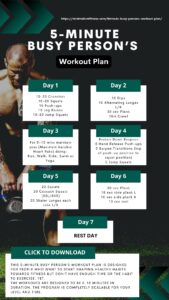Kettlebell exercises have been around for centuries and are a popular form of strength training. Whether you’re a beginner or have experience using kettlebells, kettlebell training can help improve overall strength, endurance, and mobility. However, it is important to use proper form and technique to avoid injury.
Read on to find 28 amazing kettlebell exercises you can add to your workout program today!
Key Takeaways
- Kettlebell exercises suit beginner and advanced fitness enthusiasts and athletes.
- Kettlebell training can improve overall strength, endurance, and mobility.
- Proper form and technique are crucial for avoiding injury during kettlebell exercises.
Related Posts:
Fundamental Kettlebell Exercises
Kettlebell exercises are an excellent way to improve strength, endurance, and overall fitness. In this section, we will discuss some of the fundamental kettlebell exercises that are great for beginners.
Kettlebell Exercises for Beginners
1. Kettlebell Swing
The kettlebell swing is a staple exercise that is a hybrid of resistance training and cardio. Stand with your feet shoulder-width apart and place the bell on the floor about a foot’s length in front of you. Hinge forward and grasp the handle of the bell with both hands. Keep your weight shifted to your heels and pretend you’re hiking the bell.
Drive your hips forward and move into a standing position while swinging the bell up to shoulder height. Reverse the movement and allow the bell to fall between your legs and repeat the swing.

2. Goblet Squat
The goblet squat is another great kettlebell exercise for beginners. It is an excellent exercise for developing lower body strength and mobility. To perform a goblet squat, hold the kettlebell with both hands at chest height. Squat down, keeping your chest up and your knees tracking over your toes. Return to the starting position and repeat for several repetitions.

3. Kettlebell Deadlift
The kettlebell deadlift is an excellent exercise for developing lower body strength and power. To perform a kettlebell deadlift, stand with your feet shoulder-width apart and hold the kettlebell with both hands. Hinge at the hips and lower the kettlebell towards the ground, keeping your back straight. Return to the starting position and repeat for several repetitions.

Related Posts:
- How To Master Proper Kettlebell Swing Form With These 6 Steps
- RDL vs Deadlift – Master these 2 posterior chain exercises
Training Program focused on Kettlebell exercises

Check out our Kettlebell 66 Program! An easy to follow training program for those who like kettlebell exercises.




Muscles Targeted by Kettlebell Training
Kettlebell training is a highly effective way to target multiple muscle groups at once. Here are some of the muscles that can be targeted with kettlebell exercises:
Kettlebell Exercises for arms
4. Lunge rows
A lunge row with a kettlebell is a simple exercise you can perform that doesn’t take up much space. Place your foot beside your bell and take a big lunge step back with the other leg. Grab the handle of the bell and pull the bell up. Focus on rowing into your hip so that your shoulder pulls the full range.

5. Kettlebell press
The kettlebell press isn’t just as simple as grabbing a bell and pressing it over your head repeatedly, that’s a recipe for injury! As with any exercise, it must be practised with proper form. Start with the kettlebell in the rack position. Ensure your elbow is tucked in close to your body. Press the bell directly over your head into the straight-arm position. Reverse the movement and lower the bell back to the rack position.

Related Posts:
Kettlebell Exercises for Chest
6. Floor press
Place the bell on the floor and lay down next to it. Roll onto your side and grip the handle from underneath. Then roll back onto your back. Your elbow should be 45 degrees away from your body. Brace and press the bell up. The bell should finish above your shoulder. Bring your elbow back down to tap the floor and press up.
The floor press can be adapted in various ways. You can take it from the floor to a bench or you can work out one arm at a time or both. Watch the floor press here.

7. Push ups
Kettlebell push ups take your standard push up to the next level. Rather than pushing up from the floor, grab the handle of each kettlebell and get into the push up position. Lower your body and drive up.
Kettlebell Exercises for Core and Abs
8. Turkish get up
Earlier, we talked about the Turkish get as a great exercise for the shoulders. It’s also a great exercise for your core as it leads to better trunk stability and rotational stability. Remember that slow is smooth, smooth is fast. Take your time and engage your core when performing the movement.

9. Kettlebell windmill
We’ve discussed how the kettlebell windmill is great for shoulder mobility, but it’s also an excellent core exercise. When performing the windmill, focus on your rotation and make sure your feet are on that 45-degree angle.

10. Loaded Carry
Using single or double kettlebells pick them up and walk. It’s that simple! You can change the position by moving from:
- Farmers (beside the body)
- Rack (the top position of your kettlebell clean)
- Overhead
Pick what works for you for the distance you want to carry them. A simple kettlebell workout is trying to carry your kettlebells for maximum distance over a set time. Watch this video to see the various types of loaded carries.
Related Posts:
Kettlebell Exercises for Shoulder
For shoulder exercises, nothing beats the range of mobility, stability and strength-based movements you can do with kettlebells. In this section, we’re going to focus on mobility and stability kettlebell exercises.
11. Kettlebell Halo
Start in a half-kneeling or tall kneeling position. Turn the bell upside down and grip the handle so your hands are on either side of the handle. Your chin should be in line with the bottom of the bell. Maintain an upright position and pass the bell around your head. Repeat and change directions.
See the kettlebell halo in action here.

12. Kettlebell windmill
The kettlebell windmill is a great exercise that emphasises shoulder mobility. Begin with your kettlebell in the rack position and then perform a press. Pivot your feet on 45 degrees facing the same way. Extend your other arm down the inside of your thigh until your fingers reach the floor. At the same time, hinge your upper body down. Keep your lat sucked to the hip throughout the movement. Reverse and return to the top of the movement.
13. Turkish get up
The Turkish get up is a well-known exercise for shoulder stability. Start on the floor lying on your right side with your bell in front of your stomach. Grasp the bell with your right hand and roll onto your back with your legs at a 45-degree angle. Your right leg should be bent with your foot on the floor. Extend your arm and press the bell up. Drive your body up and across into the post position. Pivot your hand on your unloaded arm to get to the tall sitting position.
Move into the bridge position and sweep your leg under your hips and get into the side kneeling position. Your hand, knee, and foot should all be in line with each other on the backside. Come up into the half kneeling position and windshield wiper your foot so that you are in a lunge position. Lunge up into the standing position. Reverse the movement and come back down to the start.
14. Double Kettlebell Press
Do kettlebells build muscle? They will if you can master the double kettlebell press. Once you have perfected the double kettlebell clean, squeeze the handles of both bells as tight as you can. Maintaining a vertical forearm just like the single kettlebell press, drive the kettlebells to the top position.

15. Bottoms Up Kettlebell Press
The bottoms-up kettlebell press helps improve shoulder stability and strength. Crushing the handle of the kettlebell, clean the bell up to the rack position so the bulb is facing the roof. Keep tension on the handle, and drive the kettlebell to the overhead position.

Kettlebell Exercises for Back
For this section, we mean the posterior chain. The kettlebell has numerous benefits but a big one is the level of attention you can put to your posterior chain, posture and back. That’s probably why I recommend a kettlebell being the first piece of equipment to purchase for any at-home workouts.
16. Lunge rows
A lunge row with a kettlebell is a simple exercise you can perform that doesn’t take up much space. Place your foot beside your bell and take a big lunge step back with the other leg. Grab the handle of the bell and pull the bell up. Focus on rowing into your hip so that your shoulder pulls the full range.
17. Renegade Row
Starting on top of two kettlebells in a push up position, row a single kettlebell to your hip. To help the movement you will need to have your feet wide enough that you don’t lose balance or stability.
18. Single arm deadlift (asymmetrical deadlift)
The single-arm deadlift is one of the many variations of a kettlebell deadlift. Stand with your feet shoulder-width apart and place the bell on the floor between your legs. Hinge forward and grab the handle of the bell with one hand. Squeeze your glutes and reverse the hinge to return to the standing position.
Reverse the movement and return the bell to the floor. Focus on keeping your back straight during the exercise. Repeat with the other arm. Learn more about the single arm deadlift here.
19. Single leg deadlift
Hold your bell by the handle on one side of your body. Hinge down whilst extending one leg back and lowering your bell to the floor. Reverse the hinge and return to the standing position.
The side you pick for your bell will determine the difficulty of the movement. If your bell is on the opposite side of your extended leg, this is the more difficult version. Remember to focus on control rather than depth.
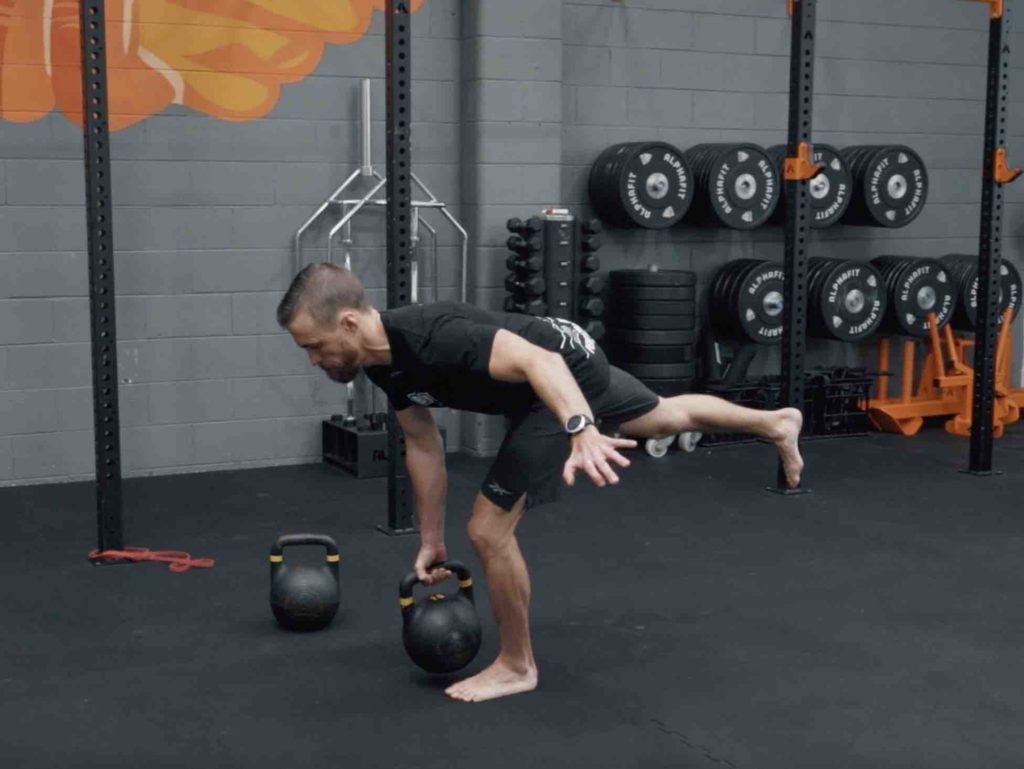
20. Single arm swing
The single or one-arm kettlebell swing is a variation of the standard two-arm kettlebell swing. Stand with your feet shoulder-width apart and place the bell on the floor about a foot length in front of you. Hinge forward and grasp the handle with one hand. Extend your unloaded arm out from your side. Keep your weight shifted to your heels and swing the bell back between your legs. Drive your hips forward and move into a standing position while swinging the bell up to shoulder height. Reverse the movement and let the bell fall between your legs. Repeat the swing.
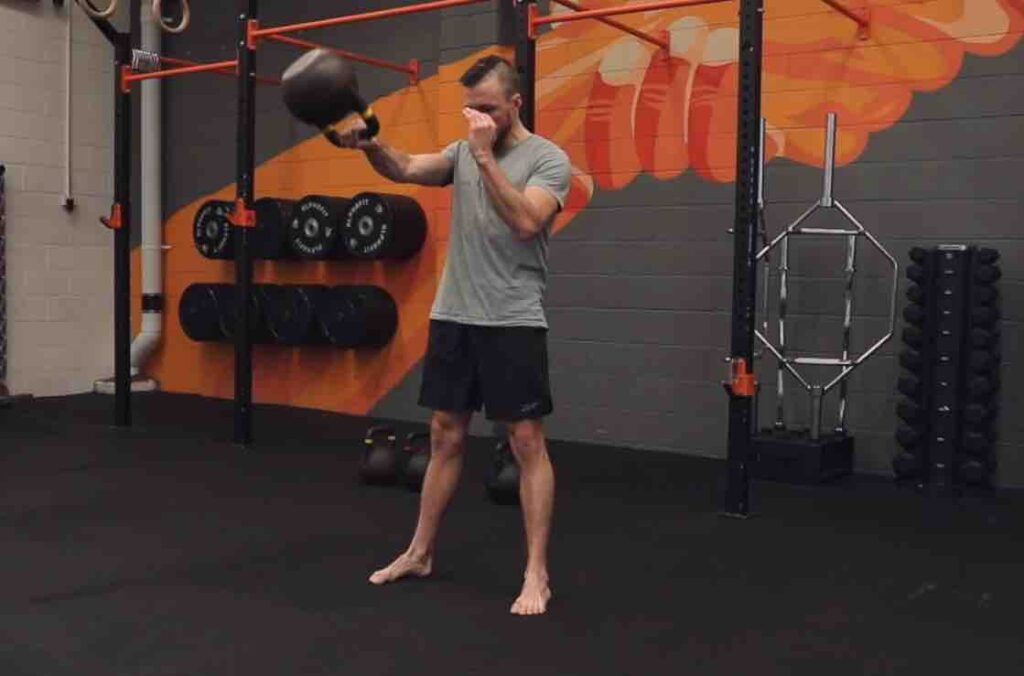
21. Kettlebell clean
The kettlebell clean is an explosive movement that is the basis for most kettlebell exercises. Stand a foot length back from your bell. The bell should be in the instep of the side you are performing the movement. Hinge forward and grasp the bell with one hand. Shifting the weight back to your heels, swing the bell between your legs.
Reverse and hinge and pop your hips. As you get into the standing position, pull your bell arm up while keeping the bell close to your body. Quickly punch through the top of the movement to allow your bell to come back into the rack position. Reverse the steps and return the bell to the floor.
Kettlebell Exercises for Legs and Glutes
22. Single arm deadlift
As with many kettlebell exercises, the single arm deadlift works multiple muscle groups in a single exercise. It’s a great exercise for your posterior chain and can help make everyday activities such as lifting things from the floor easier.
There are many variations to this movement that will help to vary your workouts such as the suitcase deadlift, the kickstand deadlift, and the single leg deadlift.
23. Single leg deadlift
We’ve already gone through the single leg deadlift as a great back exercise, but it’s also beneficial for your hamstrings and glutes too. This exercise develops your balance on a single leg and can help you identify any imbalances as one side is often stronger than the other.
Once you have mastered the single-leg deadlift, you can consider increasing the difficulty by using one kettlebell in each hand.
24. Goblet squat
The goblet squat is a great exercise, not just for the lower body but also to help maintain upright stability when you’re perfecting your squat form. Stay over the top of your bell and grab the handle with both hands. Drive up into a standing position. Squat down, pulling in with your hips into the bottom position. Your elbows should meet the inside of your knees. Drive up into the top position while maintaining an upright posture.
25. Single Kettlebell Rack Squat
With a single kettlebell in the rack position after finishing your clean, follow the same steps as the goblet squat. Be careful of the kettlebell trying to rotate you out of position with the uneven weight.
26. Double Kettlebell Squat
After a double kettlebell clean, pull in with the hips into the bottom of the movement. This time, be sure not let the kettlebells pull you forward.

27. Bottoms Up Kettlebell Squat
Just like the bottoms-up kettlebell press, get a kettlebell into the rack position with the bulb of the bell facing the roof. Without letting the kettlebell rotate you out of position, squat down until you hit the right depth.
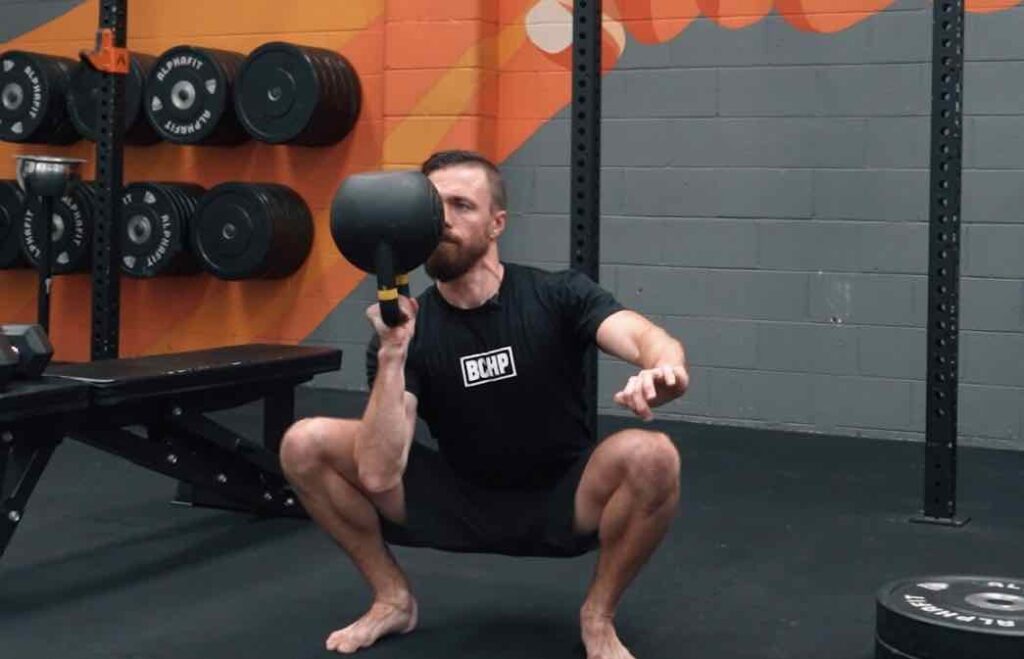
28. Overhead Kettlebell Squat
The ultimate expression of overhead mobility and stability with kettlebells. Clean or snatch a kettlebell overhead (you can also use double kettlebells). Maintaining the correct overhead position, squat down until the hips become parallel to the knees, if you have the range of motion go until you hit ass to grass.
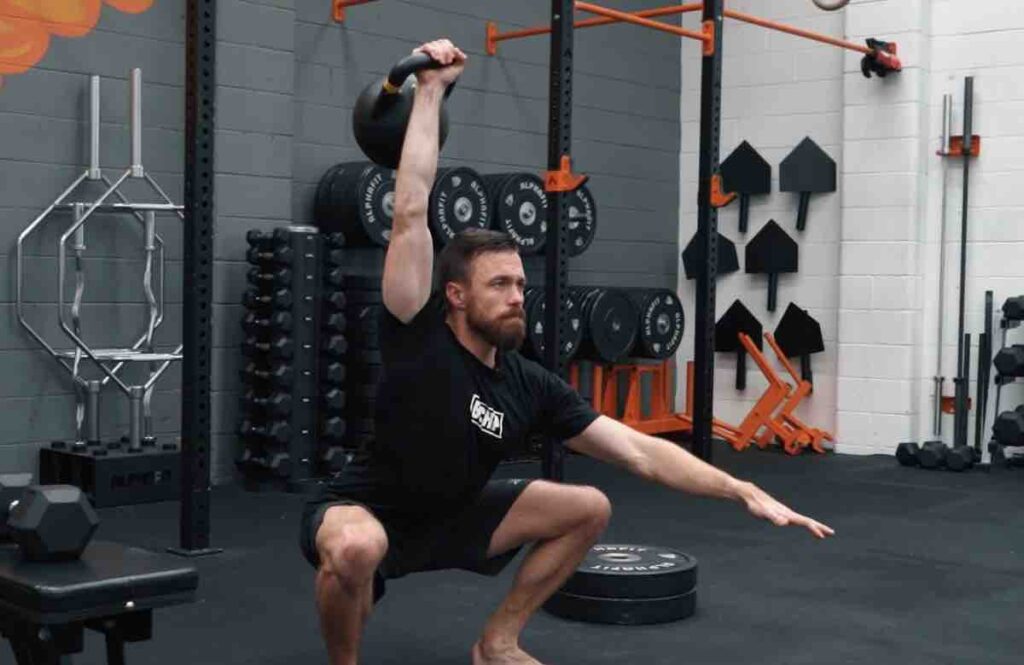
29. Bulgarian Split Squats
The final type of squat exercise for your legs and glutes that I would recommend is the Bulgarian split squat or “rear foot elevated” split squat. Why you may ask? If you’ve ever loaded up with heavy kettlebells and completed multiple sets of split squats, you would know by the feeling you get the next day. These are great for highlighting any asymmetries in the body to avoid injury but also great for hypertrophy of the glutes and legs.
Related Posts:
- The Split Squat – 9 Exercises To Build Stronger Legs
- How To Improve Squat Mobility and Form In 4 Simple Steps
Full Body Kettlebell Exercises
As you may have observed throughout this article, a lot of the kettlebell exercises can also be used for full-body workouts. Kettlebell swings, snatches, get ups and cleans are all great exercises for targeting multiple muscle groups at once.
Related Posts:
- Learn the kettlebell clean | The Definitive 6 step Guide
- 5 Steps to a better Turkish Get Up
- Master the kettlebell snatch in 5 steps
Creating a Kettlebell Workout Routine
When creating a kettlebell workout routine, it is important to keep in mind the number of reps and time for each exercise. Beginners may start with fewer reps and shorter intervals, while more advanced individuals may increase the number of reps and time for each exercise.
A full-body workout can be achieved with kettlebell exercises by incorporating exercises that target different muscle groups. Coaches or trainers can provide guidance on proper form and technique to ensure maximum effectiveness and prevent injury.
Here are some examples of kettlebell exercises that can be included in a workout routine:
- Kettlebell swings
- Goblet squats
- Turkish get-ups
- Single-arm rows
- Overhead presses
It is important to vary the exercises and routine to prevent boredom and plateauing. A well-rounded kettlebell workout routine can lead to improved overall fitness and strength.
Related Posts:
Frequently Asked Questions
How heavy should my kettlebell be?
The weight of your kettlebell will depend on your fitness level and goals. For beginners, it is recommended to start with a lighter kettlebell, around 8-12kg for women and 12-16kg for men. As you progress, you can increase the weight gradually.
It’s important to note that the weight of the kettlebell should challenge you, but not to the point where you compromise your form. Proper form is crucial to avoid injury and get the most out of your workout.
Can I get injured using kettlebells?
As with any exercise, there is always a risk of injury if proper form and technique are not followed. It’s important to start with a lighter weight and focus on proper form before moving on to heavier weights.
Common injuries associated with kettlebell exercises include strains, sprains, and lower back pain. To avoid injury, it’s recommended to warm up properly before starting your workout, use proper form, and avoid overexertion.
If you have any pre-existing medical conditions or injuries, it’s important to consult with your doctor before starting any new exercise program, including kettlebell exercises.
